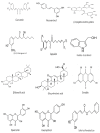South Asian Medicinal Compounds as Modulators of Resistance to Chemotherapy and Radiotherapy
- PMID: 26959063
- PMCID: PMC4810116
- DOI: 10.3390/cancers8030032
South Asian Medicinal Compounds as Modulators of Resistance to Chemotherapy and Radiotherapy
Abstract
Cancer is a hyperproliferative disorder that involves transformation, dysregulation of apoptosis, proliferation, invasion, angiogenesis and metastasis. During the last 30 years, extensive research has revealed much about the biology of cancer. Chemotherapy and radiotherapy are the mainstays of cancer treatment, particularly for patients who do not respond to surgical resection. However, cancer treatment with drugs or radiation is seriously limited by chemoresistance and radioresistance. Various approaches and strategies are employed to overcome resistance to chemotherapy and radiation treatment. Many plant-derived phytochemicals have been investigated for their chemo- and radio-sensitizing properties. The peoples of South Asian countries such as India, Pakistan, Sri Lanka, Nepal, Bangladesh and Bhutan have a large number of medicinal plants from which they produce various pharmacologically potent secondary metabolites. The medicinal properties of these compounds have been extensively investigated and many of them have been found to sensitize cancer cells to chemo- and radio-therapy. This review focuses on the role of South Asian medicinal compounds in chemo- and radio-sensitizing properties in drug- and radio-resistant cancer cells. Also discussed is the role of South Asian medicinal plants in protecting normal cells from radiation, which may be useful during radiotherapy of tumors to spare surrounding normal cells.
Keywords: ABC transporter; South Asian plants; chemoresistance; phytochemicals; radioresistance.
Figures



Similar articles
-
Cytotoxicity of South-African medicinal plants towards sensitive and multidrug-resistant cancer cells.J Ethnopharmacol. 2016 Jun 20;186:209-223. doi: 10.1016/j.jep.2016.04.005. Epub 2016 Apr 4. J Ethnopharmacol. 2016. PMID: 27058630
-
Liberalising trade in health services: constraints and prospects for South Asian countries.Int J Health Plann Manage. 2015 Jan-Mar;30(1):57-70. doi: 10.1002/hpm.2205. Epub 2013 Jul 13. Int J Health Plann Manage. 2015. PMID: 23852984
-
Women and the media in South Asia.Media Asia. 1987;14(4):218-27, 235. doi: 10.1080/01296612.1987.11726265. Media Asia. 1987. PMID: 12281077
-
Scientific basis for the use of Indian ayurvedic medicinal plants in the treatment of neurodegenerative disorders: ashwagandha.Cent Nerv Syst Agents Med Chem. 2010 Sep 1;10(3):238-46. doi: 10.2174/1871524911006030238. Cent Nerv Syst Agents Med Chem. 2010. PMID: 20528765 Review.
-
Towards safe injection practices for prevention of hepatitis C transmission in South Asia: Challenges and progress.World J Gastroenterol. 2016 Jul 7;22(25):5837-52. doi: 10.3748/wjg.v22.i25.5837. World J Gastroenterol. 2016. PMID: 27433097 Free PMC article. Review.
Cited by
-
Targeting the hallmarks of cancer: the effects of silibinin on proliferation, cell death, angiogenesis, and migration in colorectal cancer.BMC Complement Med Ther. 2021 May 31;21(1):160. doi: 10.1186/s12906-021-03330-1. BMC Complement Med Ther. 2021. PMID: 34059044 Free PMC article.
-
Antibiotic resistance modifying ability of phytoextracts in anthrax biological agent Bacillus anthracis and emerging superbugs: a review of synergistic mechanisms.Ann Clin Microbiol Antimicrob. 2021 Dec 2;20(1):79. doi: 10.1186/s12941-021-00485-0. Ann Clin Microbiol Antimicrob. 2021. PMID: 34856999 Free PMC article. Review.
-
The role of HIF-1α in chemo-/radioresistant tumors.Onco Targets Ther. 2018 May 22;11:3003-3011. doi: 10.2147/OTT.S158206. eCollection 2018. Onco Targets Ther. 2018. PMID: 29872312 Free PMC article. Review.
-
How Effective are Key Phytocompound Carrying Polysaccharide Nanocarriers as Anti-Breast Cancer Therapy? A Comprehensive Review of the Literature.Int J Nanomedicine. 2025 Jun 27;20:8393-8413. doi: 10.2147/IJN.S520580. eCollection 2025. Int J Nanomedicine. 2025. PMID: 40599396 Free PMC article. Review.
-
Cytotoxic and chemomodulatory effects of Phyllanthus niruri in MCF-7 and MCF-7ADR breast cancer cells.Sci Rep. 2023 Feb 15;13(1):2683. doi: 10.1038/s41598-023-29566-0. Sci Rep. 2023. PMID: 36792619 Free PMC article.
References
-
- Jain J.B., Kumane S.C., Bhattacharya S. Medicinal flora of Madhya Pradesh and Chhatisgarh-A review. Indian J. Tradit. Know. 2006;5:237–242.
-
- Garg A., Darokar M.P., Sundaresan V., Faridi U., Luqman S.R., Khanuja S.P.S. Anticancer activity of some medicinal plants from high altitude evergreen elements of Indian Western Ghats. J. Res. Educ. Indian Med. 2007;13:1–6.
-
- Molnar J., Engi H., Hohmann J., Molnar P., Deli J., Wesolowska O., Michalak K., Wang Q. Reversal of multidrug resitance by natural substances from plants. Curr. Top. Med. Chem. 2010;10:1757–1768. - PubMed
-
- Aggarwal B.B., Ichikawa H., Garodia P., Weerasinghe P., Bhatt I.D., Pandey M.K., Shishodia S., Nair M.G. From traditional Ayurvedic medicine to modern medicine: Identification of therapeutic targets for suppression of inflammation and cancer. Expert. Opin. Ther. Targets. 2006;10:87–118. doi: 10.1517/14728222.10.1.87. - DOI - PubMed
Publication types
LinkOut - more resources
Full Text Sources
Other Literature Sources

